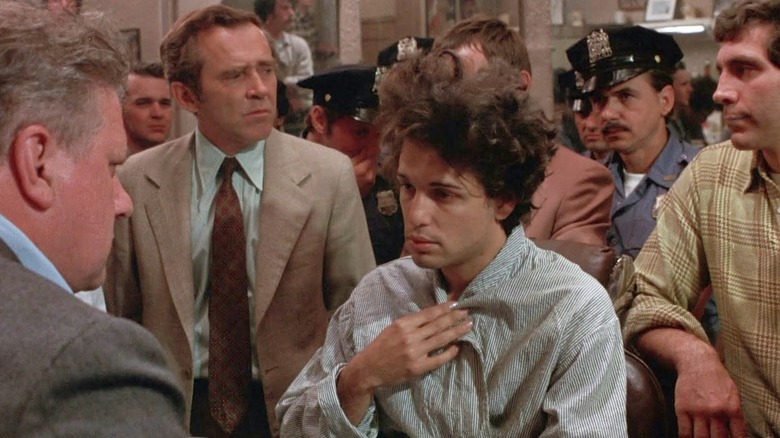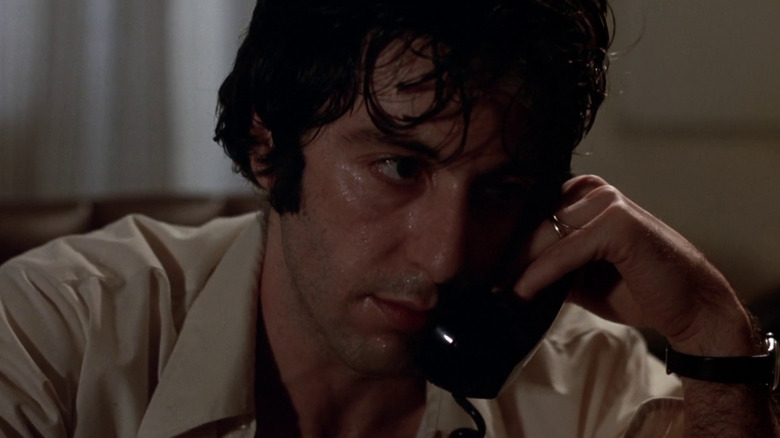We could obtain a fee on purchases produced from hyperlinks.
In Sidney Lumet’s terse 1975 basic “Canine Day Afternoon,” primarily based on the 1972 Life Journal biography “The Boys within the Financial institution” by P.F. Kluge, Al Pacino performs Sonny Wortzik, the ringleader of a first-time financial institution robbing group. He and his cronies — together with Sal (John Cazale) and Stevie (Gary Springer) — have set their sights on the First Brooklyn Financial savings Financial institution, considering they’ll get out and in with minimal fuss and a pile of money. The whole lot goes fallacious instantly, nevertheless. Stevie flees the scene, leaving his compatriots slightly stranded, and Sonny learns that the day by day pickup has already occurred, leaving him with solely $1,100 in money.
The scenario merely snowballs from there. A small fireplace within the financial institution alerts the police and Sonny locks himself contained in the financial institution, forcing him right into a hostage scenario. Sonny, not a profession prison, continues to be suspicious of all cops, seeing because the notorious Attica Jail Riot had taken place lower than a yr earlier than. That riot, to remind readers, noticed jail guards murdering 43 inmates, making it the deadliest jail rebellion in historical past. Sonny, clearly, would not wish to be murdered by cops, chanting “Attica! Attica!” to a now-gathered crowd of onlookers (itself a well-known second improvised by Pacino).
However why did Sonny even wish to rob a financial institution? It appears that evidently his trans girlfriend, dwelling by the identify Leon (Chris Sarandon), required cash for gender-affirming surgical procedure. Sonny has a spouse, Angie (Susan Peretz), and kids, however they’re estranged. After some time, Sonny realizes that the scenario is nicely past his management and that his dying may on the very least present insurance coverage cash for his spouse and children and cash for his girlfriend’s surgical procedure.
Sonny and Leon largely talk from a distance, though there was a scene within the movie’s script whereby the 2 had been to have an in-person kiss … with Leon dressed as Marilyn Monroe. In accordance with Pacino’s new autobiography “Sonny Boy” (by way of Leisure Weekly), the actor objected to the drag scene, feeling it was in poor style. Basically, Pacino noticed it as an absurd and cartoony tackle Leon that deviated too removed from the in any other case life like scenario.
Pacino thought Canine Day Afternoon’s preliminary script was too exaggerated
Leon, it needs to be famous, relies on the real-life Elizabeth Eden, whereas Sonny was primarily based on the real-life financial institution robber John Wojtowicz. John and Elizabeth married in a public ceremony in 1971, and Wojtowicz did certainly maintain up a financial institution in Brooklyn, not less than partly to purchase gender-affirming surgical procedure for his spouse. The cash he acquired from the making of “Canine Day Afternoon” ended up paying for Eden’s surgical procedure.
In an early script draft for the movie, screenwriter Frank Pierson penned a scene whereby Leon, dressed as Marilyn Monroe, got here to the financial institution to placate Sonny, and the 2 had been to have a giant kiss in entrance of the group. Pacino learn the scene and felt it inappropriately embellished the real-life relationship between Wojtowiz and Eden. “Canine Day Afternoon,” many may level out, beneficial properties its creative energy from its realism, staying firmly in relatable, wholly tense conditions. Dressing Leon as a full-blown drag performer would make a queer character an excessive amount of of a caricature. Pacino wrote that “Not solely was it not true, it was overly exaggerated,” including that it was “a comedic send-up of some kind that minimized the scenario.”
Pacino recalled his dialog with Lumet, whereby he defined:
“We’re coping with human beings, whether or not they’re heterosexual or gay. We’re simply human beings. I believed, why are we speaking about this? Would the cops have let that type of show happen? […] In our movie, the police enable Sonny and Leon to have a cellphone name wherein they’re successfully telling one another goodbye. This movie was primarily based on a real story, in spite of everything, and I did the analysis and located that they made a cellphone name. They did not kiss; they did not even contact. Nobody was dressed up as Marilyn Monroe. It by no means went down like that.”
Pacino and Sarandon, as an alternative, co-wrote their scenes collectively.
Pacino was not involved about Sonny’s sexuality
Pacino famous that he and Sarandon spent loads of time rehearsing collectively, improvising dialogue in character. When the time got here for the 2 actors to rehearse their fateful phone name, they each improvised the entire scene, a lot to Lumet’s blessing. The “Canine Day Afternoon” script was then backward engineered to match what they stated, solely barely cleaned up for readability.
Ever since “Canine Day Afternoon” was launched, many viewers and critics have theorized how Sonny may outline his sexuality. He married a cisgender lady, however left her for a trans lady who was nonetheless dwelling life largely as a person. Was Sonny bisexual? Pacino, nevertheless, is not so involved with the labels one may use, extra targeted on the humanity of the character. He discovered Sonny intriguing for his emotional journey, and gave no thought to how “daring” it is likely to be to play a queer character. He simply performed a personality in love. Because the actor put it:
“What I interpreted from the screenplay was that he’s a person with a spouse and children who additionally occurs to be in an affair with an individual who identifies as a girl, and who as we speak we’d perceive is transgender. However understanding this about him did not excite me or hassle me; it did not make the function appear any extra interesting or dangerous. […] Maybe [in 1975] it was an unusual factor to have a major character in a Hollywood film who was homosexual or queer, and who was handled as heroic or worthy of an viewers’s affection, however it’s important to perceive that none of that enters into my consideration.”
Which is, after all, an admirable angle.



